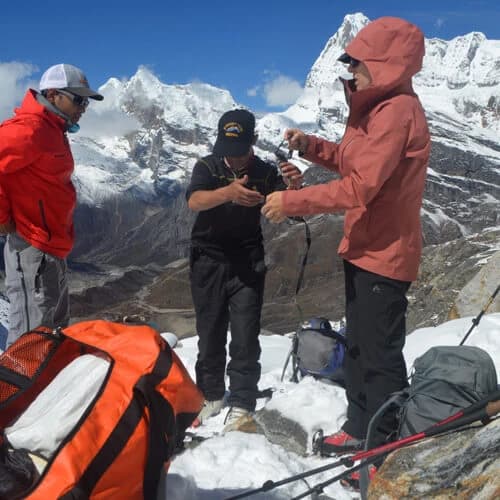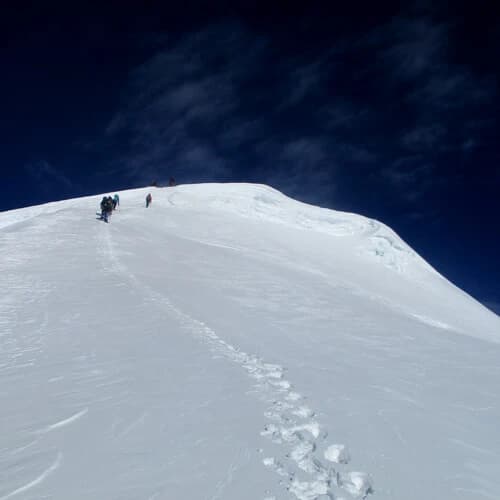What is Mera Peak Climb?
Mera Peak Climb is a thrilling combination of high-altitude mountaineering and trekking in Nepal's remote Hinku Valley. It is one of the highest trekking peaks in the country and offers a challenging yet rewarding climb to adventure enthusiasts.
The climb is a great means for both beginning and experienced climbers to develop experience in Himalayan mountaineering. With fewer crowds than other summits in the Everest region, Mera Peak provides a sense of solitude, Himalayan scenery, and accomplishment.
Technical Aspect of the Mera Peak Climb
The Nepal Mountaineering Association (NMA) grades Mera Peak as a non-technical climb. The summit lies within the Mahalangur range in the Himalayas, close to Mount Everest. There are three main summits: Mera Peak North, Mera Peak Central, and Mera Peak South.
It requires basic mountaineering skills and knowledge of how to use crampons, ropes, and ice axes. During this expedition, climbers must walk on glaciers and cross ice moraines with the help of gears and equipment. The ascent to the top is predominantly snow and ice slopes of a moderate incline but does not include vertical climbing or complex rope works.
Overall, Mera Peak is an excellent choice for those who want to begin their journey into the mountaineering world. It is a rewarding experience that provides exposure to high-altitude trekking and climbing, preparing you for your future adventures.
Understanding the Difficulties of the Mera Peak Climbing Expedition
Technical Climbing Sections
Mera Peak is a graded Alpine PD, indicating moderate difficulty with semi-technical climbing sections. Climbers must navigate icy slopes, glacial moraines, and crevasses using essential gear like crampons, ice axes, and fixed ropes. The final ascent involves steeper, more technical terrain, requiring basic mountaineering skills and careful footing.
Weather and Temperature
The weather and temperature on Mera Peak are highly unstable and can fluctuate rapidly, especially at higher altitudes. Trekkers should be prepared for sudden weather events like heavy snowfall and wind storms, especially in winter. On the other hand, climbing Mera Peak during the Peak Season of spring and autumn offers optimal weather conditions. The temperature is stable, ranging from 10°C to 12°C, and drops below freezing at night.
Challenges of High-Altitude Exposure
Climbing Mera Peak involves significant high-altitude exposure as you ascend above 6,000m. The reduced oxygen levels of about 9% at the summit pose serious risks, including Acute Mountain Sickness (AMS), HACE, and HAPE. Spending multiple days above 5,000m increases the chances of altitude-related illnesses, making acclimatization crucial. It is also important to abide by general guidelines like gradual ascent and rest to avoid the risk of altitude sickness.
Physical Fatigue
The Mera Peak expedition is physically demanding, requiring great endurance, stamina, and mental strength. Trekkers must ascend steep inclines, crevassed glaciers, and uneven trails with the help of proper gears and equipment. In addition, long days of trekking with heavy backpacks make the climb more challenging. So, trekkers must be in good health with good
cardiovascular fitness and lower body strength to trek for multiple days.
Mental Exhaustion
Climbing Mera Peak demands not only physical strength but also mental resilience. The remote region, challenging weather, and long durations of isolation can lead to stress and anxiety. Furthermore, the lack of comfort and familiarity increases the sense of despair and emotional stress. So, staying close to your group, sharing experiences, and being positive becomes crucial in overcoming mental fatigue and staying motivated throughout the expedition.
Choosing the Right Route
Deciding on the finest route for Mera Peak is not about doing what everyone else is doing but what makes you the most comfortable. If you prefer a gentle grind or a rugged push, do what works best for you, bodily and mentally. Pick the path that delights you, nourishes you, and motivates you. Let's discuss each of the routes individually:
Mera Peak Route 1:
The most direct and fastest way to Mera Peak from Lukla is by passing over Zatra La Pass (4,610m) and then going down to Tagnag, Mera Base Camp. Finally, the summit is Route 1. It's fast but strenuous, with little time to acclimatize at high altitudes. Even experienced climbers have considered this route tough due to the steep and rapid ascent. This route isn't recommended unless you're well-prepared and used to high altitudes. It may be the quickest but also the riskiest for the unprepared.
Mera Peak Route 2:
Route 2 is the most used route to Mera Peak, and it has a more extended but considerably safer climb than the direct one. It starts in Lukla and meanders through scenic Khumbu villages like Pauya, Panguam, and Nagindingma, giving you more time for acclimatization. It has various acclimatization stops and tented camps along the trail, making the trip more comfortable. When you reach the summit, your body is accustomed to the higher altitude. It's suitable for first-time climbers or anyone seeking a less tiring and more relaxed climb.
Mera Peak Route 3:
Route 3 is the easiest and most beginner-friendly route to Mera Peak because of its longer itinerary and generous acclimatization time. It follows the Everest Base Camp route as far as Namche Bazaar so that you can explore the lower Everest region and Sherpa villages. While the longest route is far from boring, it consists of stunning scenery and deep cultural immersion. With several days to acclimate before ascending high elevations, this route makes the ascent safer, easier, and more pleasurable for novice mountaineers.
Altitude Sickness Risks and Acclimatization Strategies
The Ascent of Mera Peak exposes trekkers to the risk of altitude sickness due to its high altitude of 6,476 meters. Symptoms range from as benign as discomfort but also potentially as fatal as HAPE or HACE. Proper acclimatization is essential to minimize these risks so climbing can be safe and successful. By prioritizing acclimatization and listening to your body, you can reduce the risk of altitude sickness and maximize your ability to summit Mera Peak safely.
Common Symptoms of Altitude Sickness:
- Headache, nausea, and dizziness
- Shortness of breath and fatigue
- Insomnia
- Loss of appetite
Successful Acclimatization Methods:
- Trek through the Hinku Valley for a gradual increase in elevation.
- Drink adequate fluids throughout the day.
- Maintain energy levels through regular meals and snacks.
- Both smoking and drinking will make symptoms worse.
- Include acclimatization rest days in the itinerary.
- Make day hikes at higher altitudes and rest days shorter.
- Take acetazolamide (Diamox) on medical recommendation if needed.
- Don't ignore symptoms if they worsen descend.
Physical Conditioning: Preparing for the Mera Peak Climb
Preparation for climbing Mera Peak requires good body fitness since trekking entails extensive daily walks, strenuous ascents, and altitude challenges. An intense training program must begin at least three months before and focus on building cardiovascular fitness, leg stamina, and overall endurance.
- Brisk walking with a loaded day pack, running, cycling, and climbing stairs are excellent ways to build cardiovascular endurance for hiking at high altitudes.
- Exercises like skipping, jumping jacks, sit-ups, squats, and weight lifting can strengthen your legs and core muscles.
- Enhance your mobility and flexibility by practicing yoga and stretches to improve balance and footing.
- Maintain a balanced diet with nutrient and protein-rich meals and beverages to replenish your body.
Note: Mental strength is as important as physical fitness when climbing Mera Peak. It allows climbers to stay focused and positive even when conditions become difficult. A calm, supple state of mind is needed to overcome the psychological pressures and fully enjoy the summit experience.
Essential Climbing Skills: Crampons, Ice Axe, and Ropes
Climbing Mera Peak requires basic mountaineering skills and knowledge of crampons, ice axes, ropes, and harnesses. Although not technically challenging, the last part of the summit involves glacier crossings on snowy terrain and icy slopes.
- Practice the use of crampons as it provides essential traction on hard snow and ice and provides stability.
- Learn to handle ice axes because it is an important support tool in climbing.
- Participate in rock climbing exercises to learn how ropes protect against slips and falls during the ascent.
Note: For beginners, proficiency in basic skills in advance enhances confidence and success on the mountain. Having the necessary skills is paramount for a fulfilling and safe experience on Mera Patk.
Gear and Equipment: Essential for Safety
The right gear and clothing are required for an effective and safe ascent of Mera Peak. While technically not complex, the extreme elevation, icy terrain, and changing weather necessitate specialized gear.
Head:
- Sun hat/cap (For sun protection on trekking days)
- Warm beanie (Wool or fleece)
- Balaclava / Buff/neck gaiter (For wind and cold protection)
- Glacier sunglasses
- Ski goggles (wind and snow protection)
- Headlamp + extra batteries
Upper body:
- Base Layers (Merino wool or synthetic thermal tops)
- Mid Layers (Fleece jacket or pullover)
- Outer Layers (Waterproof hardshell jacket)
- Gloves (Lightweight, Insulated, Wind/waterproof shell)
- Undergarments
Lower body:
- Base Layer (Merino wool or synthetic)
- Trekking Pants
- Outer Layer (full zip preferred for ease with boots)
- Down pants or insulated over pants ( for the windy summit)
Foot:
- High-altitude double mountaineering boots
- Comfortable trekking boots (worn-in, waterproof)
- Camp shoes/sandals (for teahouse and base camp use)
- Socks (Wool trekking and mountaineering)
- Gaiters (snow and crampon protection)
Accessories/ gear
- Climbing harness
- Helmet
- Crampons (compatible with boots)
- Ice axe
- Ascender (Jumar) + carabiners + slings
- Climbing rope
- Trekking poles
- Sleeping bag
- Sleeping pad
- 30–40L Daypack
- 60–70L Duffel bag
- Bottle (for hydration)
Extras and essential
- Sunscreen, lip balm (SPF 50+)
- Toiletries (toothbrush, biodegradable soap, quick-dry towel)
- Wet wipes
- Hand sanitizer
- Small medical kit (with Diamox, blister kit, painkillers)
- Water purification tablets
- Snacks
- Power bank
- Passport, permits, extra photos
- Cash (NPR)
Some Most Popular Treks




